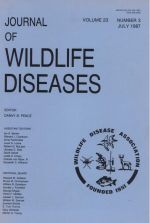Clinical salmon poisoning disease (SPD), and survival of Neorickettsia helminthoeca and metacercariae of Nanophyetus salmincola in fish were evaluated experimentally in 12-wk-old coyotes (Canis latrans) to determine the potential of SPD for biological control of coyotes. Coyotes readily ate fish that contained metacercariae and rickettsiae. They developed diarrhea, anorexia and lethargy within 7 days after feeding. Infected coyotes lost 58% of their body weight when compared to uninfected controls. They died or became moribund and were euthanatized within 17 days after feeding. Rickettsiae were present in the macrophages of lymph nodes of all affected coyotes. Clinical disease occurred in coyotes fed fresh fish, but not in coyotes fed fish stored at 4 C for ≥30 days or at −20 C for 14 days. Metacercariae in fish were viable after 60 days at 4 C. These trematodes developed in coyotes, but clinical SPD did not occur. This indicated survival of metacercariae, but not rickettsiae. Metacercariae were not viable after 14 days at −20 C.
How to translate text using browser tools
1 July 1987
SALMON POISONING DISEASE IN JUVENILE COYOTES: CLINICAL EVALUATION AND INFECTIVITY OF METACERCARIAE AND RICKETTSIAE
W. J. Foreyt,
J. R. Gorham,
J. S. Green,
C. W. Leathers,
B. R. LeaMaster

Journal of Wildlife Diseases
Vol. 23 • No. 3
July 1987
Vol. 23 • No. 3
July 1987
coyotes
experimental infections
Nanophyetus salmincola
Neorickettsia helminthoeca
Salmon poisoning diseases




